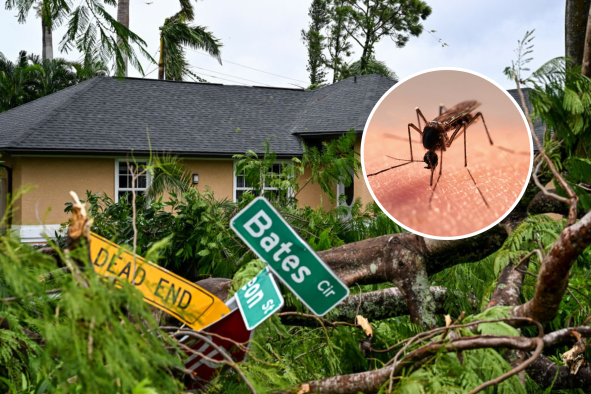Geomagnetic storms wreaking havoc in our atmosphere last night and today may hamper efforts to aid recovery in the wake of Hurricane Milton and Helene.
The "severe" G4 geomagnetic storm sparked auroras across the U.S. on Thursday night, with less powerful but still significant solar storms expected to continue throughout Friday.
NOAA's Space Weather Prediction Center said in an advisory on Thursday ahead of the storm that the storm "could impact ongoing recovery efforts for Hurricanes Helene and Milton in several critical ways."
Hurricane Milton's landfall as a Category 3 hurricane on the coast of Florida on Wednesday night, only a week and a half after Helene hit the same state, resulted in huge damage across the region. The storm brought winds of more than 100 mph, which ripped the roof of the Tropicana Field—the home stadium of MLB's Tampa Bay Rays—to shreds, as well as dangerous storm surge and heavy rainfall.
The impacts of the geomagnetic storm may make it even more difficult for FEMA to help with hurricane recovery.
"Systems that depend on low-Earth orbit satellites or High-Frequency communication may experience disruptions," the SWPC said. "The storm could put additional stress on power grids already weakened by the hurricanes."
"Navigation systems, especially those relied upon in disaster relief, may be degraded. SWPC has already updated FEMA and several state agencies involved in recovery operations."
This ongoing geomagnetic storm is caused by a coronal mass ejection (CME) that released from sunspot AR3848 at the same time as a powerful X1.8-flare on October 8. Coronal mass ejections are huge plumes of solar plasma spat out from the sun during periods of intense magnetic activity.
If a CME collides with the Earth's magnetic field, and their magnetic fields are aligned in a certain way, they can cause geomagnetic storms. This results in the charged particles of the CME being funneled into the Earth's upper atmosphere, where they react with the gas and generate the bright-colored lights we know as the aurora.
"A nice impact of solar activity are the northern and southern lights," Peter Gallagher, head of astronomy and astrophysics and director of the Dunsink Observatory at the Dublin Institute for Advanced Studies, told Newsweek.
Geomagnetic storms can also damage electrical grids, affect satellite operations, and GPS.
"The affected infrastructure that is of most importance is large-scale power grids, without which modern society would not be able to function," Brett Carter, an associate professor in space science at RMIT University in Australia, previously told Newsweek.
"Geomagnetically Induced Currents (GICs) are imposed on the power grids, and operators need to contend with them to make sure the equipment does not become overloaded; this is effectively what caused the widespread power outages across Quebec in the infamous 1989 storm. However, research over recent decades has significantly improved the resilience of power grids in key areas."
More powerful geomagnetic storms can result in more severe impacts to infrastructure, and also cause the northern lights to be seen further south than usual. The geomagnetic storm last night hit a G4 in strength, which is the second-most powerful form a geomagnetic storm can take, resulting in the aurora being seen from states including Alabama, Mississippi, Texas and southern California, with people catching a glimpse even as far south as Cuba and Mexico.
"The geomagnetic field is likely to maintain G3-G4 (Strong to Severe) conditions into 11 Oct if the Bz component continues to sustain a southward orientation and connect well with Earths magnetic field. A gradual recovery is anticipated on 12 Oct, with G1 (Minor) geomagnetic storm levels likely in the early hours of the UTC day," the SWPC said in a 3-day forecast advisory.
The SWPC forecasts G3-G1 conditions throughout October 11, with some G1 conditions on October 12.
Do you have a tip on a science story that Newsweek should be covering? Do you have a question about CMEs? Let us know via science@newsweek.com.
Disclaimer: The copyright of this article belongs to the original author. Reposting this article is solely for the purpose of information dissemination and does not constitute any investment advice. If there is any infringement, please contact us immediately. We will make corrections or deletions as necessary. Thank you.



